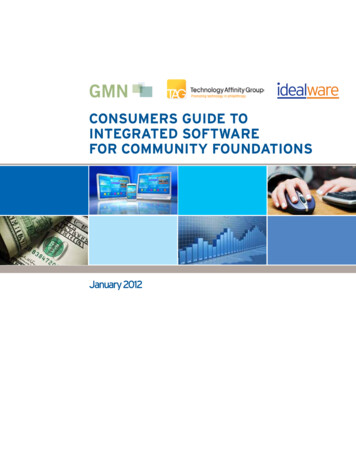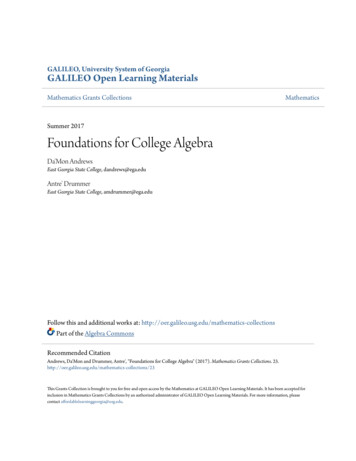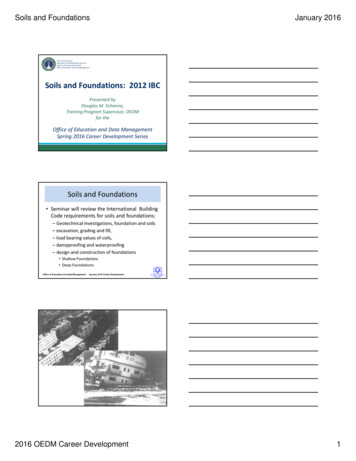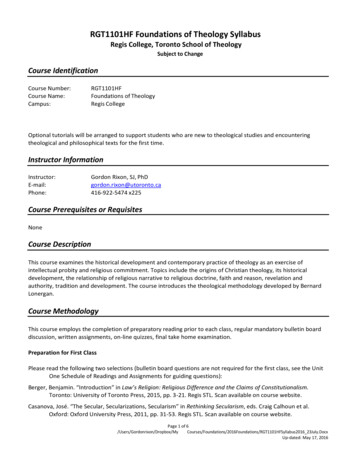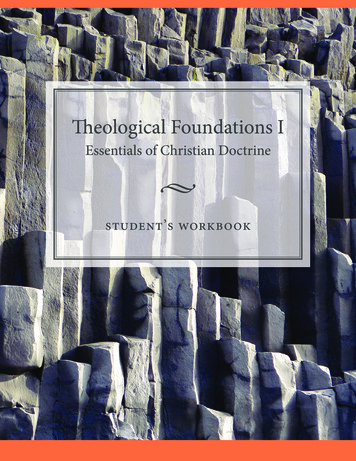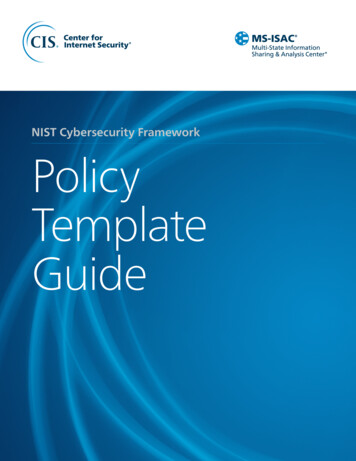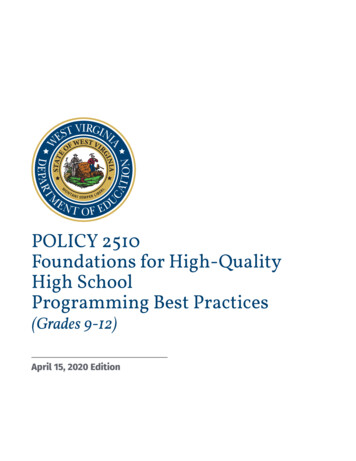
Transcription
T IO NENANIBI SEMPER LERICANT.OWIRNI AGIMMOFADE PA RTSTATET VIRGINISE WEST VT OF E DUPOLICY 2510Foundations for High-QualityHigh SchoolProgramming Best Practices(Grades 9-12)April 15, 2020 Edition
Table of ContentsArts.2Computer Science.3English Language Arts (ELA).5Mathematics.7Physical Education.12Driver Education. 14Science.15AP Credit in Social Studies and Science.17Social Studies. 18Personalized Education Plan (PEP).20Career Technical Education (CTE).21West Virginia Career Cluster. 22Community Readiness. 26Social and Emotional Advisory System for Student Success.27World Languages.30Embedded Credit. 33Dual Credit. 34West Virginia Virtual School. 35West Virginia eLearning for Educators. 37Instructional Resources.38Integration of Additional Standards.40APPENDIX – Mathematics Standards.411
ArtsSubjectGraduationRequirementsPersonalized Course OptionsThe Arts1 credit1 Personalized CreditRequired to be Offered Four sequential courses in music (both choraland instrumental), visual art (general art and/orstudio art), dance, theatreAn AP , Dual Credit, orIB Arts course may besubstituted for any Arts Course Optionscredit. Arts Offerings Arts College CoursesThe following CTE courses will fulfill the 1 credit Artsrequirement: Fundamentals of Illustration (1851) Fundamentals of Graphic Design (1857) Illustration (1861) Graphic Design Applications (1859) Ornamental Metal Work (1982) Digital Imaging/Multimedia I (1431) Drafting Techniques (1727) Floriculture (0213)GuidanceIt is imperative that students verify high school course choices with their chosen post-secondaryinstitution of learning. Additionally, it is imperative that students review post-secondary programentrance requirements, including requirements of NCAA, PROMISE, other scholarships, and admissionsto specific institutions, various majors, honors programs, etc.Counties may choose to offer a variety of arts courses to allow students to personalize this creditrequirement.ResourcesThe Kennedy Center, ards.aspxNational Coalition of Core Arts Standards (2014), http://nationalartsstandards.org2
Computer ScienceSubjectGraduationRequirementsComputer SciencePersonalized Course OptionsRequired to be Offered One Course in Computer ScienceAdditional Course Options Computer Science in the Modern World AP Computer Science Courses Information Technology (IT) Information Management Web Development Other courses based on student need and interest CTE Computer Science/IT Courses County-created Computer Science/IT Courses College Computer Science CoursesGuidanceIt is imperative that students verify high school course choices with their chosen post-secondaryinstitution of learning. Additionally, it is imperative that students review post-secondary programentrance requirements, including requirements of NCAA, PROMISE, other scholarships, and admissionsto specific institutions, various majors, honors programs, etc.Technology is integrated throughout 9-12 classroom experiences as a tool to facilitate the learningprocess. Technology-infused activities should, if possible, extend the learning environment beyond thenormal school day or setting and extend the development of digital citizenship skills in students.Computer science is integrated throughout 9-12 classroom experiences as a tool to developcomputational thinking, networking, data analysis, programming, and the societal impacts of computing.All high schools must offer at least one Computer Science course. These include, but are not limited to:2801AP Computer Science A2805IB Computing Studies2806AP Computer Science Principles3030AP Computer Science A (fourth math credit)3161Computer Science & Mathematics (fourth math credit)6045Computer Science – Introduction to Geographic Information Systems (third science credit)2872Computer Science in the Modern World2811Basic Computer2816Basic Programming2821Computer Graphics2826Computer Science & Information Systems3
2831Computer Science/Programming2836Computer Systems2841Computer Technology2846General Computer Applications2851Network Technology2856Object-Oriented Language2861Operation Systems2866Pascal ProgrammingCourses from these CTE pathwaysIT2210Advanced Careers InformaticsIT2215Computer Science – Project Lead the WayIT1640Cisco Networking AcademiesIT1680Computer Systems Repair TechnologyIT1442Coding, App, and Game DesignIT1445Simulation and Game DevelopmentMA1630RoboticsOther CTE and locally offered Computer Science coursesPlease refer to the Course Code Manual, which is updated on a regular mResourcesCode.org. Computer Science Principles AP . e.org, Computer Science Discoveries le Education. Everyone Can Code, Introduction to App Development with Swift (1 semester). AppDevelopment with Swift (2 semesters), AP Computer Science Principles with Swift ege Board. AP Computer Science Principles. AP Computer Science mputer-science-principles?course legeboard.org/courses/ap-computer-science-a?course ap-computer-science-aBeauty and Joy of Computing. Computer Science Principles AP , Scholar. Information Technology Courses, Python, C#, Java, AP CS A, iew/Microsoft Make Code Microsoft Educator Center soft Imagine Academy Computer Science Path ng-path#csps4
English Language Arts (ELA)SubjectGraduationRequirementsPersonalized Course OptionsEnglish LanguageArts (ELA)4 credits3 Prescribed CreditsEnglish 9English 10English 11Recommended College and Career Readiness CourseOptions and Courses Required to be Offered English 12 or Transition English Language Arts forSeniors1 AdditionalPersonalized CreditsfromCourse OptionsAn AdvancedPlacement (AP ), DualCredit, or InternationalBaccalaureate (IB )ELA course may besubstituted for any ELAcredit.Additional Course Options Creative Writing and Reading Technical English Language Arts English 12 CR English Language Arts College Courses County-created and Approved English LanguageArts Courses based on student need and interestensuring state standards for English are metGuidanceIt is imperative that students verify high school course choices with their chosen post-secondaryinstitution of learning. Additionally, it is imperative that students review post-secondary programentrance requirements, including requirements of NCAA, PROMISE, other scholarships, and admissionsto specific institutions, various majors, honors programs, etc.6.2.c. Students who do not meet the college- and career-readiness benchmarks on the West VirginiaGeneral Summative Assessment for English language arts and/or mathematics prior to their senioryear may be enrolled in a designated transition English Language Arts course and/or a designatedtransition mathematics course even if they already have the required number of credits in that area.Students may enroll in a higher-level course with agreement between the student, his or her parentand/or guardian, and the school to ensure the best interests and needs of each student are met.Creative Writing and ReadingCreative Writing and Reading fulfills the fourth course credit option in English language arts forgraduation. The standards for this course are located in Policy 2520.1A, West Virginia College- andCareer-Readiness Standards for English Language Arts. Standards for this course emphasizeanalytical reading and the creation of a body of student’s original work as a reflection of growth anddevelopment in the student’s writing craft over time. Students engage in rigorous examination ofprose, poetry, and drama through the application of multiple critical lenses. Special attention is givento studying literary structures and elements beyond the scope of foundational English language artscourses.5
Technical English Language ArtsTechnical English Language Arts fulfills the fourth course credit option in English language arts forgraduation. The standards for this course are located in Policy 2520.1A, West Virginia College- andCareer-Readiness Standards. Technical English Language Arts is designed to enhance students’communication skills through relevant, industry-specific contexts for reading, writing, speaking/listening, and language. Students engage in rigorous examination of technical and career related textsthrough real and simulated professional discourse experiences.Transition English Language Arts for SeniorsTransition English Language Arts for Seniors focuses on a set of prioritized English language artsstandards for students who have not met the college- and career-readiness benchmark on the SATSchool Day or other nationally recognized college admissions assessments. These standards arelocated in Policy 2520.1A, West Virginia College- and Career-Readiness Standards for English LanguageArts. Note that NCAA may not approve this course; however, counties can individually apply for NCAAapproval. Students are responsible for verifying that their course selection will support their eligibilityas student-athletes as defined by the NCAA. Transition English Language Arts for Seniors fulfills thefourth credit requirement in English language arts for graduation and is accepted by in-state highereducation institutions.ResourcesAdlit.org. (2018). Ready for college. http://www.adlit.org/ready for college/.Southern Regional Education Board. (2013). Literacy ready: Ready for reading in all disciplines. http://www.sreb.org/page/1683/literacy ready.html6
ed Course OptionsMathematics4 credits2 Prescribed Credits*Math I or Algebra IMath II or GeometryRecommended College and Career Readiness CourseOptions and Courses Required to be Offered Math III STEM or Math III LA or Algebra II Math IV - Trigonometry/Pre-calculus, AppliedStatistics, Transition Mathematics for Seniors2 AdditionalPersonalized* Creditsfrom Course OptionsAn AP , Dual Credit,or IB Mathematicscourse may besubstituted for anyMathematics credit.Additional Course Options Math I Lab (when taught in conjunction withMath I) Algebra I Support (when taught in conjunctionwith Algebra I) Applied Statistics AP Computer Science A Advanced Mathematical Modeling Calculus Statistics Probability and Statistics Quantitative Reasoning STEM Readiness Mathematics Math III TR Math IV TR Mathematics college courses Computer Science and Mathematics County-created and Approved Math Courseshigher than Math II or Algebra II Technical Transition Math Financial AlgebraGuidanceIt is imperative that students verify high school course choices with their chosen post-secondaryinstitution of learning. Additionally, it is imperative that students review post-secondary programentrance requirements, including requirements of NCAA, PROMISE, other scholarships, and admissionsto specific institutions, various majors, honors programs, etc.*Prescribed Credits - The required Grades 9 and 10 credit courses that are specifically prescribed perpolicy (Refer to 6.1 Grades 9 through 12 Standards-focused curriculum and graduation requirements)for all content areas across grades 9 and 10.*Personalized Course Credit Options - The required Grades 11 and 12 courses that may be personalizedby student and school staff per policy (Refer to 6.1 Grades 9 through 12 Standards-focused curriculumand graduation requirements) based on the student’s post- secondary plans.7
Prior to the 2018-2019 freshman cohort students will need 24 credits to graduate.9.1.c.4. All students complete four credits of mathematics; however, a student’s enrollment in amathematics course for each year of high school must be determined by county policy.6.2.c. Students who do not meet the college- and career-readiness benchmarks on the West VirginiaGeneral Summative Assessment for English language arts and/or mathematics prior to their senioryear may be enrolled in a designated transition English Language Arts course and/or a designatedtransition mathematics course even if they already have the required number of credits in that area.Students may enroll in a higher level course with agreement between the student, his or her parentand/or guardian, and the school to ensure the best interests and needs of each student are met.6.4.a.2. Any student who successfully completes a high school level course (one meeting the highschool approved content standards and taught by a content-certified teacher) prior to grade 9 shallreceive full credit for that course toward graduation requirements. The student’s permanent recordfor grades 9-12 shall indicate completion of the courses. The grade for any credit-bearing course takenprior to grade 9 becomes part of the student’s permanent record and is calculated in the student’sgrade point average (GPA).High School Math I Lab and Algebra I Support Credit toward GraduationMathematics taught in the ninth-grade year is often referred to as “gatekeeper” content to higher levelmathematics. Struggling ninth grade students may benefit from a Math I Lab or an Algebra I Supportexperience that is responsive to their individual academic needs through a data driven decisionmaking process. Because some of the highest priority content for college and career readinesscomes from Grades 6-8, the Math I Lab and the Algebra I Support experiences should addressthe Mathematical Habits of Mind and connect to the Math I standards or the Algebra I standardswhile including powerfully useful proficiencies such as applying ratio reasoning in real-world andmathematical problems, computing fluently with positive and negative fractions and decimals, andsolving real-world and mathematical problems involving angle measure, area, surface area, andvolume.Math I Lab or Algebra I Support must be taught in conjunction with Math I or Algebra I. Uponsuccessful completion, students who are enrolled in Math I Lab and Math I, or Algebra I Support andAlgebra I in the same academic year, receive one mathematics credit toward graduation for Math ILab or Algebra I Support. Students who are enrolled in Math I Lab and Math I or Algebra I Supportand Algebra I and successfully complete one of the two courses have demonstrated mastery of thestandards of Math I or Algebra I. As a result, students who successfully complete either Math I Lab orMath I, or Algebra I Support or Algebra I, should then enroll in Math II or Geometry. Students who havesuccessfully completed Math I or Algebra I are not eligible to go back and earn a credit for the lab orsupport course. Institutions of higher education will not recognize Math I Lab or Algebra I Support as acredit. If a student fails Math I or Algebra I but passes the corresponding lab or support class and theteacher feels the student has mastered the content, the county may choose to give the student creditfor the actual course instead of the lab or support credit since the content is identical.Because institutions of higher education will not recognize Math I Lab or Algebra I Support as acredit in mathematics, if a student is planning to attend college, it will be important to check withthat institution to see if four mathematics credits are required for admission. If so, mathematics8
courses beyond the four required for graduation may be needed to meet the admission requirement.Undergraduate admission to WV four-year colleges and universities includes the completion of fourdistinct mathematics courses. Though two courses such as Math I and Math I Lab or Algebra I andAlgebra I Support may be appropriately counted as two courses towards graduation, they do not covertwo distinctly different bodies of knowledge that would be the expectation of college and universityadmission requirements.Guidance Concerning Institutions of Higher Education, the NCAA and High School GraduationRequirements:Prior to the 2018-2019 freshman cohort students will need 24 credits to graduate.Four credits of mathematics are required for graduation. Two credits of mathematics are prescribed;students must complete either Math I and Math II or Algebra I and Geometry. Two credits ofmathematics are personalized; students should carefully choose mathematics courses that best meettheir individual interests and needs. Informed decisions regarding choice of personalized mathematicscourses should include the student, his or her parent and/or guardian, and the school. Districts areencouraged to work with their mathematics leadership, teachers, and curriculum coordinators todesign course sequences that best meet the abilities and needs of their students.Students should check with their specific higher education institutions regarding mathematicsrequirements needed for admission. Undergraduate admission to WV four-year colleges anduniversities often requires the completion of Algebra II or Math III.The two courses of Math III TR and Math IV TR together only address the content of the Math III course;institutions of higher education may not recognize these as two distinct mathematics courses.It is important to note that while Math I Lab or Algebra I Support is appropriately counted as amathematics credit toward graduation, these courses do not address a distinctive body of knowledge,as would be the expectation of college and university admission requirements.Students are responsible for verifying that their course selection will support their eligibility asstudent-athletes as defined by the NCAA. The NCAA does not recognize Algebra I Support, Math I Lab,or Transition Mathematics for Seniors as credit-bearing courses for admission.Applied StatisticsApplied Statistics is among the courses identified as “Recommended College and Career ReadinessCourse Options and Courses Required to be Offered.” A team of university and high schoolmathematics educators developed content standards and resources for the Applied Statistics course.The course is designed students who have successfully addressed the mathematics content of theWest Virginia College-and Career-Readiness Standards for Mathematics for the two prescribed courses(Math I and Math II; or Algebra I and Geometry).The course is designed with a two-fold purpose – to provide engaging everyday experiences instatistical reasoning and to support students in preparation for the SAT School Day. The AppliedStatistics course provides experiences in statistics designed to strengthen students’ understanding ofthe statistical method of inquiry and statistical simulations. Students formulate statistical questions9
to be answered using data, design and implement a plan to collect the appropriate data, selectappropriate graphical and numerical methods for data analysis, and interpret their results to makeconnections with the initial question. Students use multiple representations, technology, applicationsand modeling in problem-solving contexts.Transition Mathematics for Seniors6.2.c. Students who do not meet the college- and career-readiness benchmarks on the West VirginiaGeneral Summative Assessment for English language arts and/or mathematics prior to their senioryear may be enrolled in a designated transition English Language Arts course and/or a designatedtransition mathematics course even if they already have the required number of credits in that area.Students may enroll in a higher level course with agreement between the student, his or her parentand/or guardian, and the school to ensure the best interests and needs of each student are met.Transition Mathematics for Seniors focuses on a set of prioritized mathematics standards for studentswho have not met the college- and career-readiness benchmark on the SAT School Day or othernationally recognized college admissions assessment. The course prepares students for their entrylevel credit-bearing liberal studies mathematics course at the post-secondary level. Focus is onhelping students solidify their quantitative literacy by enhancing numeracy and problem-solving skillsas students investigate and use the fundamental concepts of algebra, geometry, and introductorytrigonometry.Guidance for LEAs Considering Options in High School Mathematics Course PathwaysEach county has chosen one of the two course pathways for the mathematics progression in grades 9-11. Option 1: Pathway known as the international or integrated course sequence of Math I, Math II,and Math III. Option 2: Pathway known as the traditional course sequence of Algebra I, Geometry, and Algebra II.Accelerating High School Mathematics CoursesThe adoption of the West Virginia College- and Career-Readiness Standards provides an opportunityto reconsider practices of accelerating high school mathematics to the middle school. It is stronglyrecommended that districts systematically consider the full range of issues related to acceleratinghigh school mathematics courses at middle level grades. Districts should not be rushed or pressuredinto decisions and should develop a plan along with representative stakeholders, including parents,middle and high school teachers, counselors, and mathematics leaders.Discussions and decision-making regarding accelerating high school mathematics to the middleschool should include the following three areas of consideration: the increased rigor of the grade 8 mathematics standards; options for high school pathways that accelerate starting in grade 9 to allow students to reachadvanced mathematics courses such as Calculus by grade 12; and the offering of high school mathematics in middle school to students for which it is appropriate.10
Increased Rigor of Grade 8 Content Standards for MathematicsSuccess in the introductory high school mathematics course for either the Integrated Pathway orthe Traditional Pathway is crucial to students’ overall academic success and their continued interestand engagement in mathematics. In the past, based on perceived redundancies in content standardsduring the middle grades, districts had increasingly offered the former Algebra I course in 8th gradeto enhance rigor. The current K-8 content standards, however, represent a tight progression of skillsand knowledge that is inherently rigorous and designed to provide a strong foundation for success inthe more advanced introductory high school mathematics course, High School Mathematics I or HighSchool Algebra I.The West Virginia College-and Career-Readiness Standards for Mathematics – Grade 8 are ofsignificantly higher rigor and more coherent than traditional grade 8 mathematics standards. Thecontent standards address the foundations of algebra by including content that had been part ofprevious Algebra I courses, such as more in-depth study of linear relationships and equations, a moreformal treatment of functions, and the exploration of irrational numbers. Geometry standards relategeometry to algebra in a way that was not traditionally explored. In addition, the statistics standardsare more sophisticated than those traditionally included in middle school and connect linear relationswith the representation of bivariate data. The West Virginia College-and Career-Readiness Standardsfor Grade 8 address more algebra topics than were traditionally found in grade 8 standards.The High School Mathematics I course and the High School Algebra I course build on the grade 8standards and are correspondingly more advanced than previous Algebra I courses. Because manyof the topics traditionally included in previous Algebra I courses are in the current grade 8 contentstandards, the High School Mathematics I and High School Algebra I courses start with more advancedtopics and includes more in depth work with linear functions, exponential functions and relationships,and the previous high school content standards in statistics.The selection and placement of students into accelerated opportunities must be done carefully inorder to ensure success. It is recommended that placement decisions be made based upon a set ofcriteria including a readiness assessment to be reviewed by a team of stakeholders that includesteachers and instructional leadership.11
Physical EducationSubjectGraduationRequirementsPersonalized Course OptionsPhysical Education(PE)1 credit1 Prescribed CreditAdditional Course OptionsPE 9-12, Integrated PE, JROTC I and II will fulfill the 1 credit PEor counties may chooserequirementto offer Extracurricular/ Dual Credit CoursesInterscholastic PE Other PE courses based on student need andboth graded and noninterest paired with the integrated online coursegraded.GuidanceCounties will have the flexibility to allow, at their discretion, students to receive physical educationcredit in a variety of ways. If counties choose to offer alternate ways to deliver Physical Education it isrecommended that counties develop a policy outlining allowable options.Integrated Physical Education (WVEIS 7949)This blended learning approach combines a free abbreviated online PE course available through WestVirginia Virtual Schools, monitored by the PE teacher, with a physically active credit-bearing electivecourse (e.g., Weightlifting, Show Choir, Dance, etc.). Students will receive both the Physical Educationcredit and a credit for the physically active course if the county chooses to utilize this option.Extra-curricular/Interscholastic Physical Education Graded (WVEIS 7949)This option allows the student to earn the high school Physical Education credit by combining anextracurricular/interscholastic activity with the free online Integrated Physical Education (PE) courseavailable from the West Virginia Virtual School and administered by a local physical education teacherof record. The physical education teacher will issue and transcript a grade for this course if the countychooses to utilize this option.Extra-curricular/Interscholastic Physical Education Non-Graded (WVEIS 7948)This option allows the student to earn the high school Physical Education credit using an extracurricular/interscholastic activity. The course mus
computational thinking, networking, data analysis, programming, and the societal impacts of computing. All high schools must offer at least one Computer Science course. These include, but are not limited to: 2801 AP Computer Science A 2805 IB Computing Studies 2806 AP Computer Science Pr



